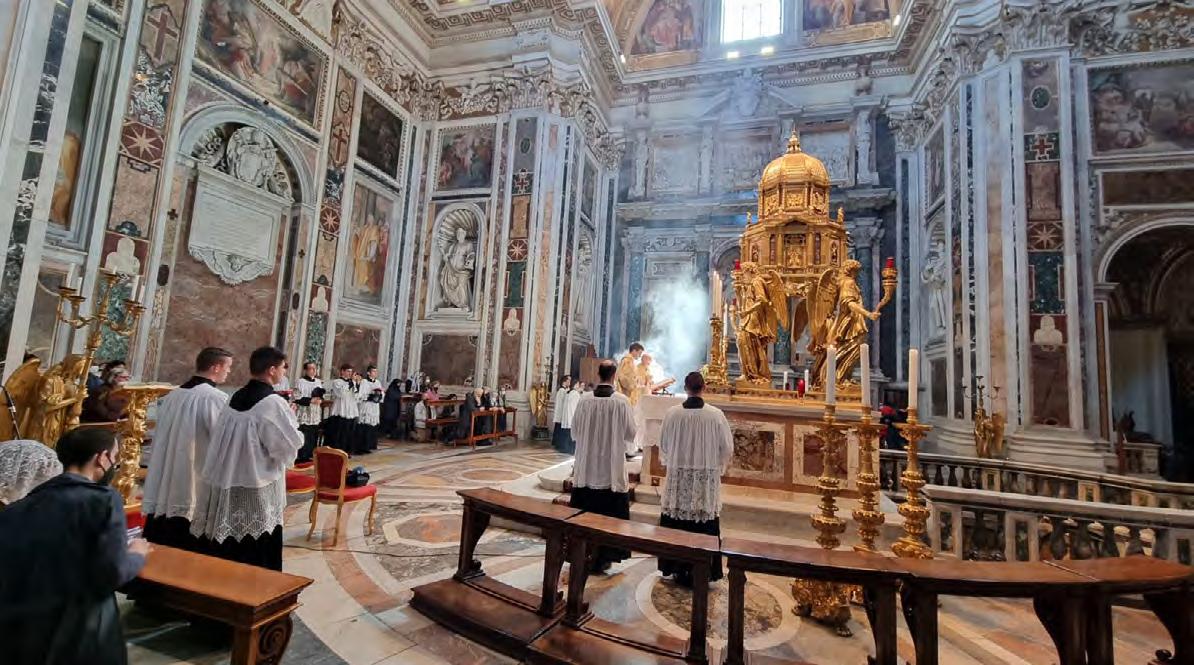
5 minute read
Art and devotion
The Communion of the Apostles
Caroline Farey on a remarkable work by the fifteenth century painter Joos van Wassenhove
Significantly, this painting was entitled the ‘Communion of the Apostles’ rather than the more usual ‘Last Supper’ and was commissioned by the Confraternity of Corpus Christi in Urbino. That sets the contemporary context for the many references to the Holy Mass, most notably, the apostles’ reception of the Holy Eucharist kneeling and on the tongue, since it was inconceivable that the Eucharist could be received in any other way in the fifteenth century when this painting was made. The title indicates that the ‘holy communion’ we receive began with the apostles at the last supper. Their communion with Christ, and our communion with Christ, is in the Eucharist.
You will notice at the centre of the painting that the table is dressed as an altar in a church in front of a columned apse, with a sanctuary lamp hanging directly above Christ’s head. We can see a tiny candle flame burning there in the deep shadow cast by the light from the window over this side of the lamp. It tells us of the light of Christ that would not be extinguished at his impending death.
You can see that the figure of Jesus is disproportionately tall at the centre of the painting where he stoops to serve his disciples. Behind Jesus, we can see the altar with two sets of items on it, visible either side of him. On the right, positioned as though Jesus has turned his back on them, are the simple remains of a meal; bread, salt and a carafe, while on the other side, above the gentle curve of Jesus’ outstretched arm we can see the sacred hosts gathered on a corporal ready for distribution in front of a chalice.
The young John, dressed in white like an acolyte, has been serving at table but now his right hand is raised in awestruck wonder, like the angels with outstretched wings adoring from above, as they do at every Eucharist.
On the far left-hand side of the painting, behind the eight reverent apostles waiting prayerfully and focused on what Jesus is giving, the figure of Judas is hovering in the doorway ready to depart. He clutches a moneybag with both hands, in contrast to the humble receptivity indicated in the faces and hand gestures of all the other apostles.
Another contrast is set up on the right-hand side, where an intriguing group, in the red hats of the Confraternity, are gesticulating in lively conversation behind the three kneeling apostles. Again, placed behind Jesus’ back, their rich attire distinguishes them from the apostles in their simpler robes and also from the undyed fabric of Christ’s plain, grey tunic. These contrasts are all to concentrate the viewer on the unsurpassable riches of Christ’s gift of himself in the Eucharist.
The head of the confraternity at this time was the Duke of Urbino, Federico da Montefeltro, for whom the artist worked. The Duke is clearly recognisable in the forefront of the group in their fine red hats, speaking with a bearded and turbaned gentleman who was a diplomatic envoy from Persia staying at the Duke’s court of Urbino at that time.
Donors and patrons of paintings are usually drawn kneeling devoutly but we have instead an animated discussion. This may have been about trade, which was the reason for the envoy’s visit and which would add to the contrast between worldly and divine riches. Looking at the Persian’s face, however, with his hand on his heart as he glances over to watch Jesus, it could also be about the person of Christ and the reality of the sacred mystery of the Eucharist.
The conversation and the Persian’s interest are being portrayed by the gestures of the man behind the Duke. These seem to be indicating that while the Persian believes in One God, illustrated by the man’s right hand holding the thumb, Christians believe in three persons in one God, illustrated by three fingers together, held slightly apart from the single finger on its own. Variations of these finger positions are very common in 15th century paintings, most especially as a blessing from the Holy Trinity, One God brought to a scene by Christ or his angels.
Directly between these two protagonists, the Persian and the Christian Duke, a woman and child can be seen in a niche behind them. Commentators say this is Guidobaldo, the Duke’s only son who was born last after several daughters and whose mother died at his birth. A woman and child will also represent the Blessed Virgin and the Christ child interceding in such a scene.
Finally, at the centre and forefront of the painting we see a jug and basin.
In St Luke’s gospel the disciples were to meet a man carrying a jar of water and to follow him into the house he enters (Lk 22:10). The Church is the house of God that we enter by baptism, the gateway to the Eucharist. John’s gospel also tells us that Jesus ‘rose from supper, laid aside his garments …poured water into a basin and began to wash the disciples’ feet.’(Jn 13:4-5). Here Jesus has risen from the table and the disciples’ feet are bare from being washed and now he begins to feed them with his very self, as he does to the faithful at every Mass.
As an altar piece, this painting would have been placed directly behind the altar so that when the sacred host was raised by the priest, the people would see it surrounded by the painted folds of the tunic of the body of Christ.
Factfile
The Communion of the Apostles, 1474 (oil on panel), by Joos van Gent (Joos van Wassenhove) (fl.1460-75) Bridgeman Images Oil on wood, 331 x 335 cm Galleria Nazionale delle Marche, Urbino https://www.wga.hu/index1.html










